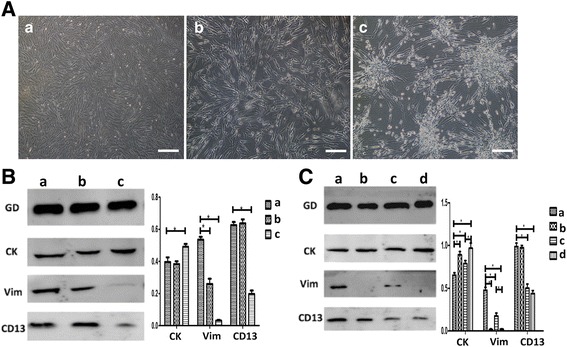Fig. 1.

WJ-MSCs differentiate into EEC-like cells in the coculture system. (A) Morphologic changes of WJ-MSCs after induced differentiation in three groups: (a) WJ-MSCs cultured both in the bottom and the membrane of the coculture system in control media (DMEM/F12 with 2% FBS). (b) WJ-MSCs cocultured with ESCs in control medium; (c) WJ-MSCs cocultured with ESCs in differentiation medium (DMEM/F12 with 2% FBS, and 1 × 107 mol/l 17β-E2, 10 ng/ml TGF, 10 ng/ml EGF, and 10 ng/ml PDGF-BB). Bar represents 200 μm. (B) Western blot analyses of cytokeratin, CD9, and vimentin in cell lysates isolated from WJ-MSCs in the three groups. Fusion proteins detected with anti-cytokeratin (CK), anti-vimentin (Vim), and anti-CD13 antibodies, and anti-GAPDH (GD) antibody was used as a loading control. Error bars represent SEM. *p < 0.05. (C) Western blot analyses of cytokeratin, CD9, and vimentin in cell lysates isolated from WJ-MSCs to show the effect of concentration of 17β-E2 on the differentiation of WJ-MSCs. Fusion proteins detected with anti-CK, anti-Vim, and anti-CD13 antibodies, and anti-GD antibody was used as a loading control. Group a, WJ-MSCs cultured both in the bottom and on the membrane and fed with control medium; Groups b, c, and d, WJ-MSCs cocultured with ESCs with different concentrations of 17β-E2 (1 × 10–8, 1 × 10–7, or 1 × 10–6 mol/L respectively) in differentiation medium. Error bars represent SEM. *p < 0.05
